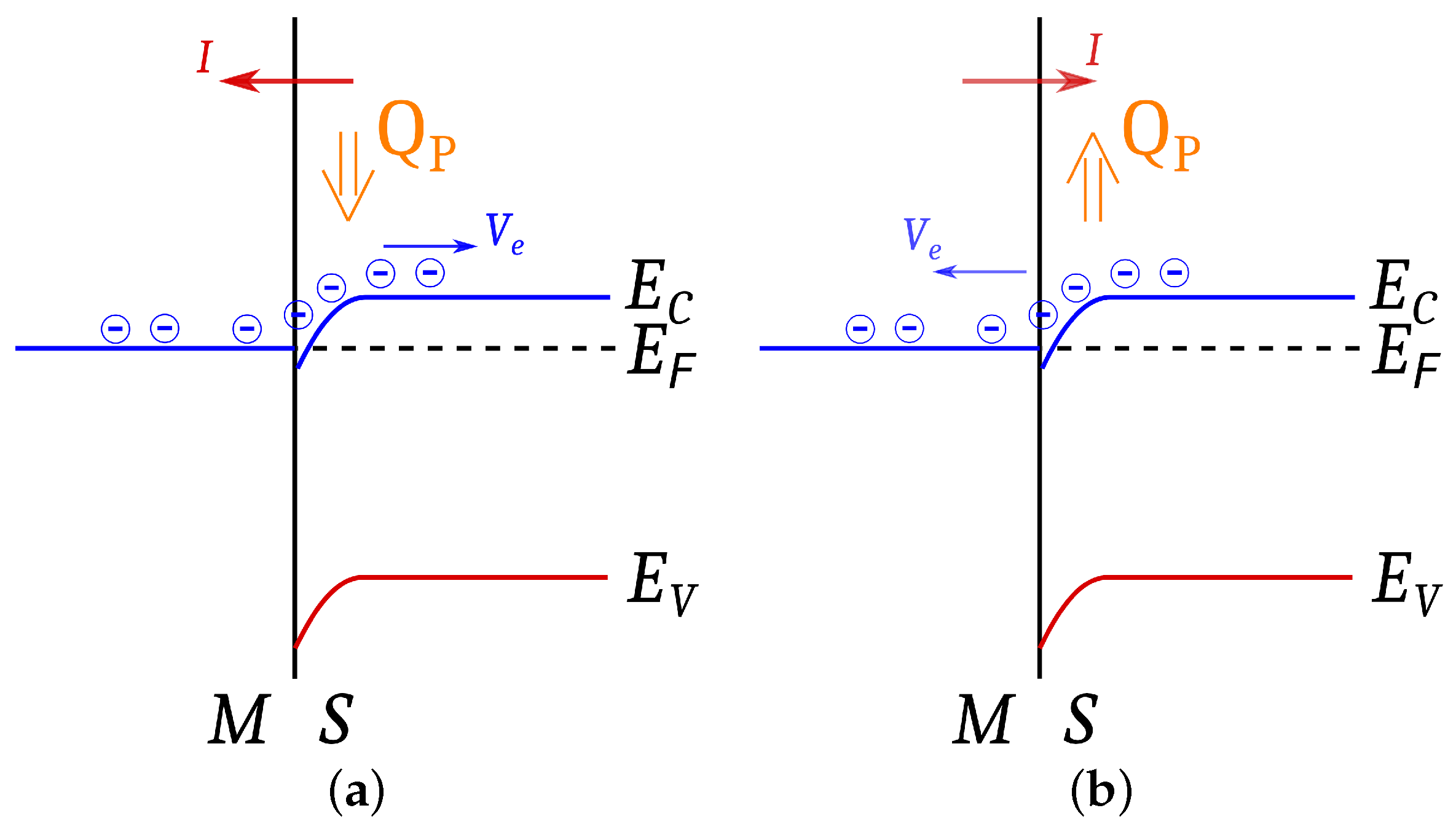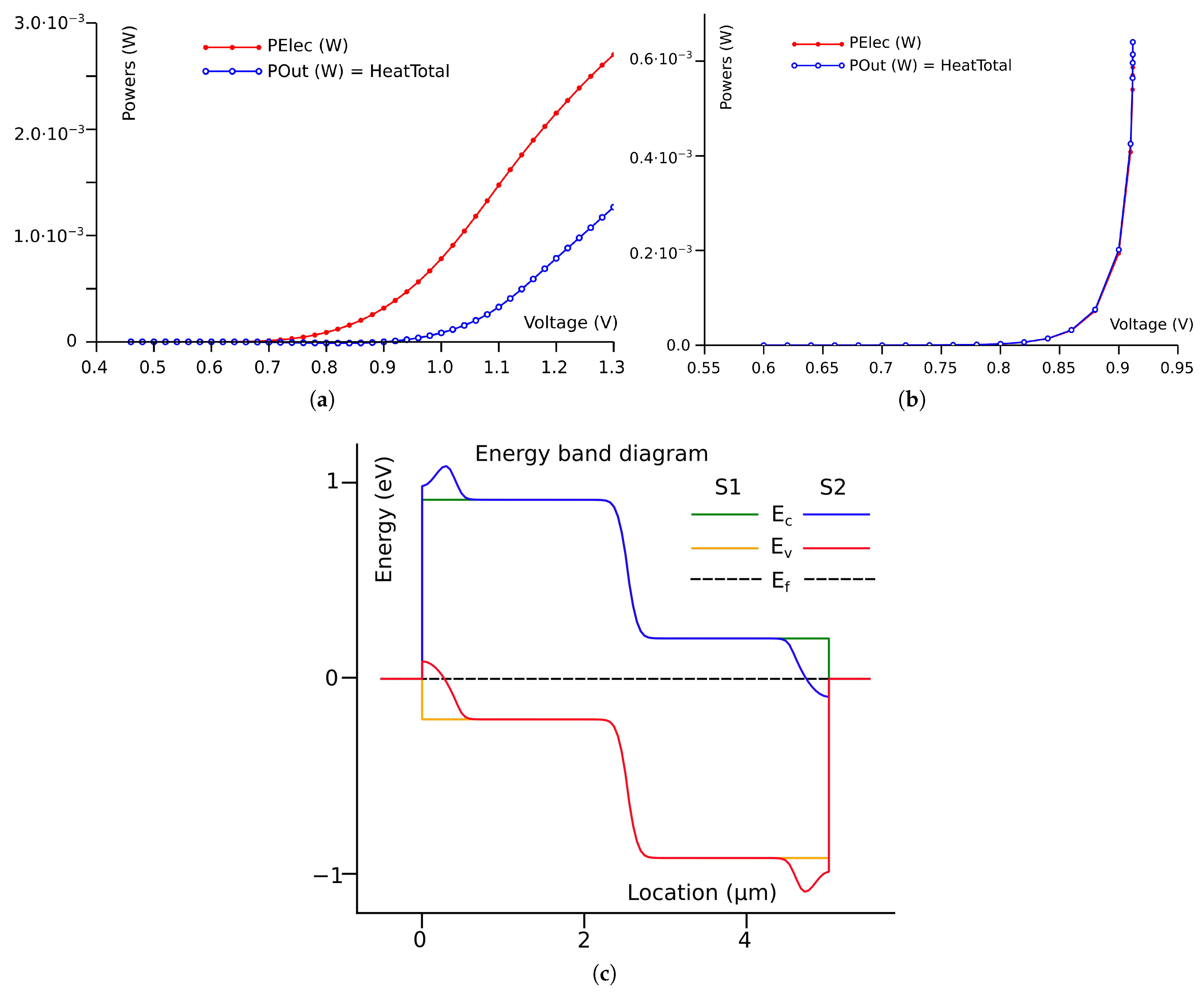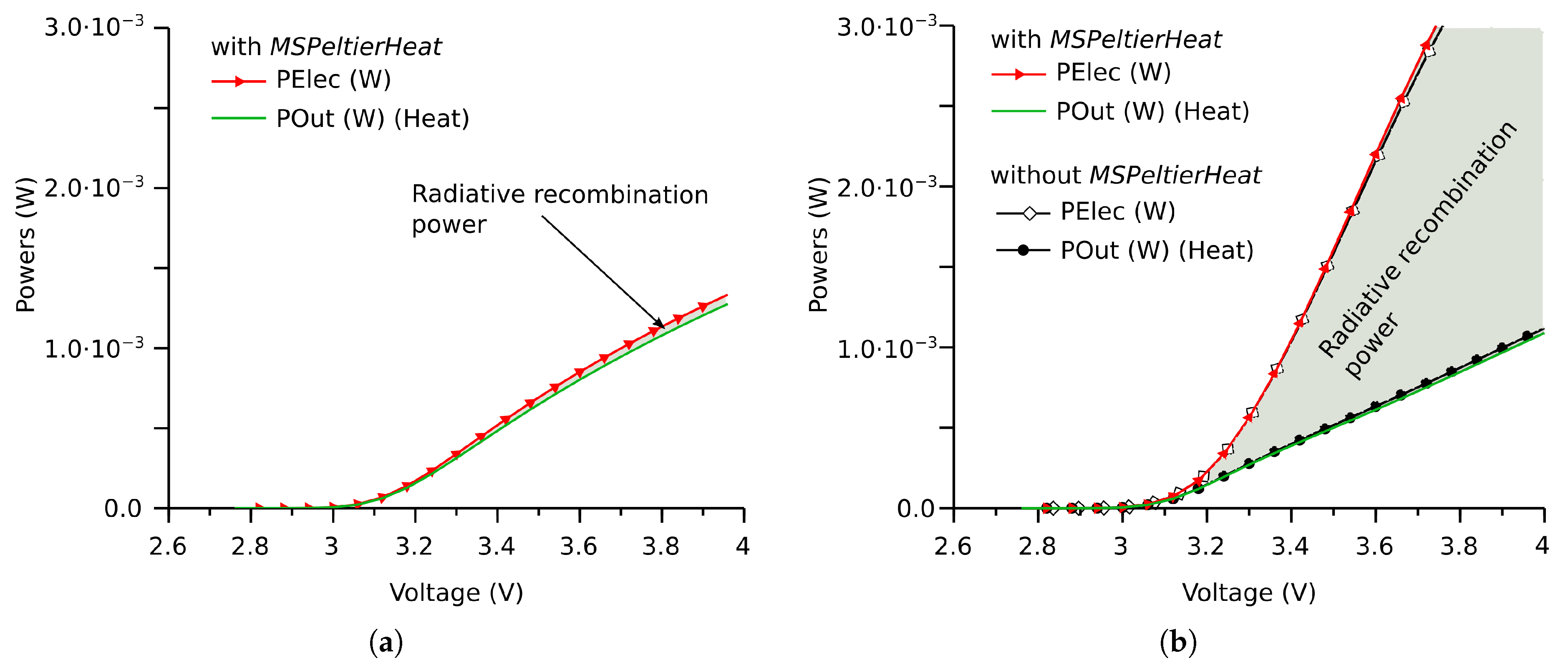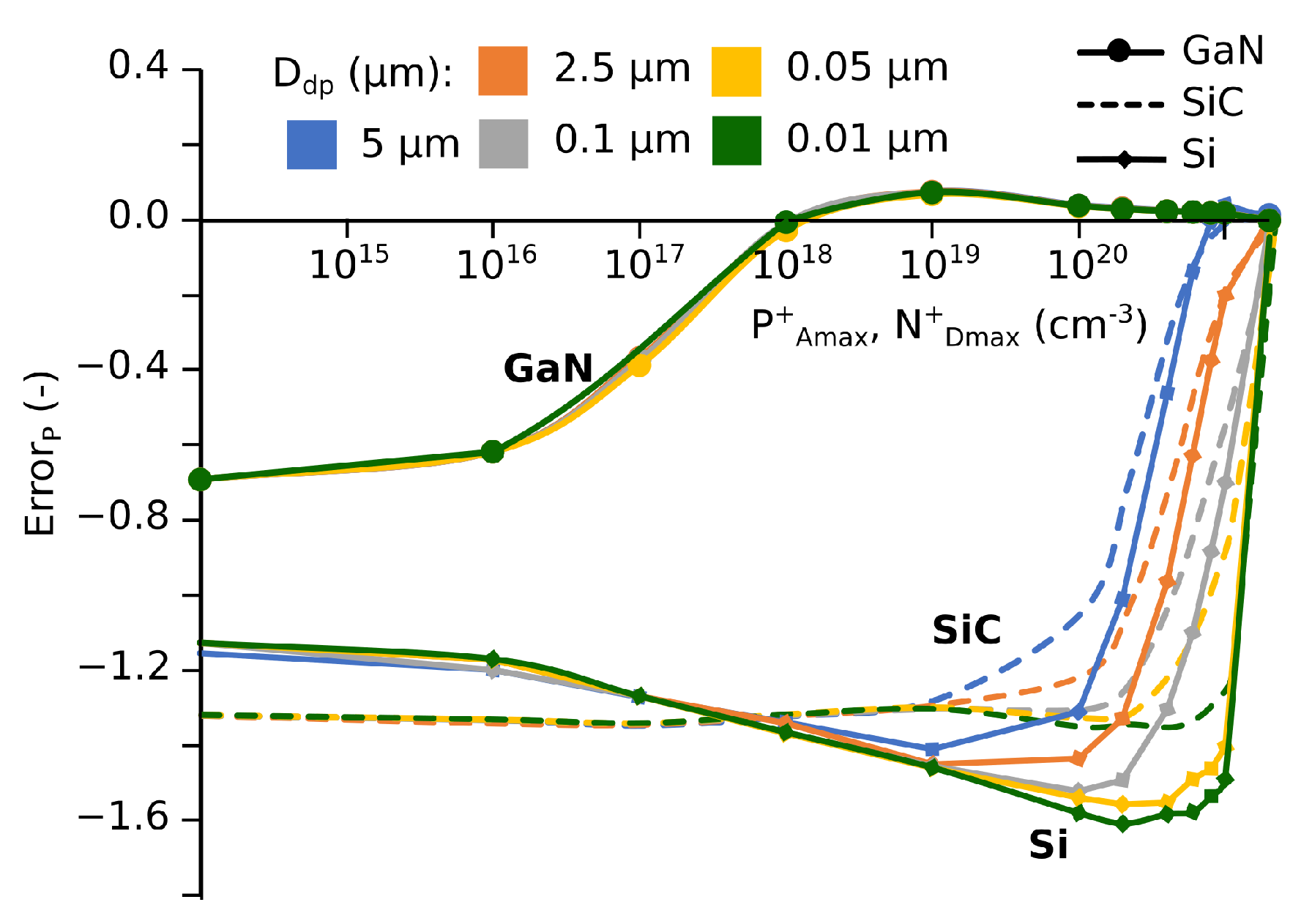Influence of the Metal–Semiconductor Interface Model on Power Conservation Principle in a Simulation of Bipolar Devices
Abstract
:1. Introduction
2. Semiconductor Structures
3. Metal–Semiconductor Interface Basics
4. Metal–Semiconductor Interface Model
5. Simulation Results for Si Structure
5.1. Energy Balance by Doping Profile Modification
5.2. Energy Balance by the MSPeltierHeat Model
6. Simulation Results for SiC and GaN
7. Influence of the Doping Profile on ErrorP
8. Summary
Author Contributions
Funding
Data Availability Statement
Conflicts of Interest
Abbreviations
| IGBT | insulated gate bipolar transistor |
| HBT | heterojunction bipolar transistor |
| MS | metal–semiconductor |
References
- Zojer, B. Driving 600 V CoolGaN(TM) High Electron Mobility Transistors; Infineon Technologies AG: Munich, Germany, 2018. [Google Scholar]
- Sentaurus. Sentaurus(TM) Device User Guide; Synopsys, Inc.: Mountain View, CA, USA, 2021; Available online: https://www.synopsys.com/search.html#q=Sentaurus(TM)%20Device%20User%20Guide&t=All&sort=relevancy (accessed on 2 December 2021).
- Silvaco. Device Simulation Software; Version 5.20. 2; ATLAS User’s Manual; Silvaco: Santa Clara, CA, USA, 2015; Available online: https://silvaco.com (accessed on 2 December 2021).
- COMSOL. COMSOL Multiphysics; v. 5.6; COMSOL AB: Stockholm, Sweden; Available online: https://www.comsol.com (accessed on 3 December 2021).
- Crosslight Software. APSYS by Crosslight Software, Inc.; Crosslight Software: Burnaby, BC, Canada; Available online: http://crosslight.com (accessed on 3 December 2021).
- Wachutka, G.K. Rigorous thermodynamic treatment of heat generation and conduction in semiconductor device modeling. IEEE Trans. Comput.-Aided Des. Integr. Circuits Syst. 1990, 9, 1141–1149. [Google Scholar] [CrossRef] [Green Version]
- Wolbert, P.B.; Wachutka, G.K.; Krabbenborg, B.H.; Mouthaan, T.J. Nonisothermal device simulation using the 2D numerical process/device simulator TRENDY and application to SOI-devices. IEEE Trans. Comput.-Aided Des. Integr. Circuits Syst. 1994, 13, 293–302. [Google Scholar] [CrossRef]
- Sentaurus. Sentaurus Technology Template: IGBT Characterization; Synopsys, Inc.: Mountain View, CA, USA, 2021; Available online: https://www.synopsys.com/search.html#q=Sentaurus%20Technology%20Template%3A%20IGBT%20Characterization&t=All&sort=relevancy (accessed on 2 December 2021).
- Pavelek, M.; Frivaldsky, M.; Sojka, P.; Morgos, J. Electro-Thermal Modelling and Experimental Verification of Power Semiconductor Diode. Elektronika ir Elektrotechnika 2020, 26, 48–53. [Google Scholar] [CrossRef]
- Kaïd, A.; Roqueta, F.; Kammerer, J.B.; Hébrard, L. Electro-thermal Modeling Method of Protection Power Diodes Using TCAD 3D/2D approach. In Proceedings of the 2019 25th International Workshop on Thermal Investigations of ICs and Systems (THERMINIC), Lecco, Italy, 25–27 September 2019; pp. 1–6. [Google Scholar]
- Fichtner, S.; Lutz, J.; Basler, T.; Rupp, R.; Gerlach, R. Electro-thermal simulations and experimental results on the surge current capability of 1200 V SiC MPS diodes. In CIPS 2014, Proceedings of the 8th International Conference on Integrated Power Electronics Systems, Nuremberg, Germany, 25–27 February 2014; VDE: Frankfurt, Germany, 2014; pp. 1–6. [Google Scholar]
- Wang, A.; Bai, Y.; Tang, Y.; Li, C.; Han, Z.; Lu, J.; Chen, H.; Tian, X.; Yang, C.; Hao, J.; et al. Analysis of Transient Surge Current Mechanism in SiC MPS Diode With the Transition Region. IEEE Trans. Electron Devices 2021, 68, 6330–6337. [Google Scholar] [CrossRef]
- Jin, R.; Wang, Y.; Li, L.; Xu, L.; Pu, K.; Zeng, J.; Darwish, M. Comparative study of electro-thermal characteristics of 4500 V diffusion-CS IGBT and buried-CS IGBT. IET Circuits Devices Syst. 2021, 15, 251–259. [Google Scholar] [CrossRef]
- Gould, C.; Shammas, N. Three dimensional TCAD simulation of a thermoelectric module suitable for use in a thermoelectric energy harvesting system. Small-Scale Energy Harvest. 2012, 29. [Google Scholar] [CrossRef] [Green Version]
- Petrosyants, K.; Torgovnikov, R. Electro-thermal modeling of trench-isolated SiGe HBTs using TCAD. In Proceedings of the 2015 31st Thermal Measurement, Modeling & Management Symposium (SEMI-THERM), San Jose, CA, USA, 15–19 March 2015; pp. 172–175. [Google Scholar]
- Wozny, J.; Podgorski, J.; Raj, E.; Lisik, Z. Good Practices of Electrothermal Simulation of pn Structures Using Sentaurus TCAD. In Proceedings of the IEEE 15th International Conference on the Experience of Designing and Application of CAD Systems (CADSM), Polyana, Ukraine, 26 February–2 March 2019; p. 1. [Google Scholar]
- OSRAM. Golden DRAGON Datasheet; OSRAM Opto Semiconductors GmbH: Regensburg, Germany, 2017; Available online: https://www.osram.com (accessed on 1 June 2019).
- Latreche, A. Combination of thermionic emission and tunneling mechanisms to analyze the leakage current in 4H-SiC Schottky barrier diodes. Semicond. Phys. Quantum Electron. Optoelectron. 2019, 22, 19–25. [Google Scholar] [CrossRef] [Green Version]
- Velmre, E.; Udal, A. Modelling of Charge Carrier Nonisothermal Transport in Silicon and Silicon Carbide. Proc. Estonian Acad. Sci. Eng. 2000, 6, 144–154. [Google Scholar]
- Conrad, K. A Physics-Based Compact Model for Thermoelectric Devices. Ph.D. Thesis, Purdue University, West Lafayette, IN, USA, 2015. [Google Scholar]
- Ofuonye, B.; Lee, J.; Yan, M.; Sun, C.; Zuo, J.M.; Adesida, I. Electrical and microstructural properties of thermally annealed Ni/Au and Ni/Pt/Au Schottky contacts on AlGaN/GaN heterostructures. Semicond. Sci. Technol. 2014, 29, 095005. [Google Scholar] [CrossRef]








Publisher’s Note: MDPI stays neutral with regard to jurisdictional claims in published maps and institutional affiliations. |
© 2021 by the authors. Licensee MDPI, Basel, Switzerland. This article is an open access article distributed under the terms and conditions of the Creative Commons Attribution (CC BY) license (https://creativecommons.org/licenses/by/4.0/).
Share and Cite
Wozny, J.; Lisik, Z.; Podgorski, J. Influence of the Metal–Semiconductor Interface Model on Power Conservation Principle in a Simulation of Bipolar Devices. Electronics 2021, 10, 3120. https://doi.org/10.3390/electronics10243120
Wozny J, Lisik Z, Podgorski J. Influence of the Metal–Semiconductor Interface Model on Power Conservation Principle in a Simulation of Bipolar Devices. Electronics. 2021; 10(24):3120. https://doi.org/10.3390/electronics10243120
Chicago/Turabian StyleWozny, Janusz, Zbigniew Lisik, and Jacek Podgorski. 2021. "Influence of the Metal–Semiconductor Interface Model on Power Conservation Principle in a Simulation of Bipolar Devices" Electronics 10, no. 24: 3120. https://doi.org/10.3390/electronics10243120






